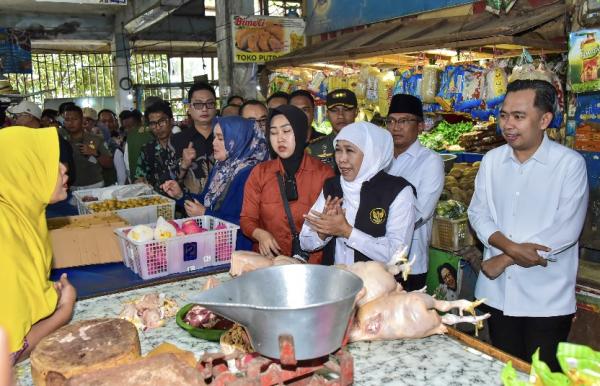JEMBER – The East Java Provincial Government has taken swift action to stabilize conditions in Jember Regency following distribution disruptions caused by fuel shortages. East Java Governor Khofifah Indar Parawansa personally visited Tanjung Market in Jember on Thursday (7/31) to assess the supply and prices of basic necessities.
The visit was in response to logistical disruptions caused by the closure of the Gumitir National Road and extreme weather in the Bali Strait area. These conditions led to long queues at Ketapang Port, delaying the delivery of fuel and essential goods to Jember.
During the inspection, Khofifah stated that overall conditions at Tanjung Market remained stable. She confirmed there had been no significant price spikes despite temporary distribution issues.
“Prices remain within normal limits. What we need to ensure is smooth logistics circulation to prevent future distribution delays,” said Khofifah.
According to Khofifah, commodities requiring special attention include medium-grade rice, Minyakita cooking oil, and granulated sugar. Based on the latest data on Thursday morning (7/31/2025), prices at Tanjung Market were as follows: Premium Rice: Rp14,900 – Rp17,000/kg, Medium Rice: Rp14,900/kg, Minyakita: Rp16,500/liter, Granulated Sugar: Rp16,000/kg, and Bulk Cooking Oil: Rp18,000/kg.
The East Java Provincial Government, along with Bulog and Jember Regency Government, is committed to overseeing the distribution of SPHP rice (Food Supply and Price Stabilization), particularly medium-grade rice, which remains limited in some markets.
“We want to guarantee uninterrupted SPHP rice distribution. Synergy between Bulog and local governments is crucial to maintaining secure supplies,” emphasized Governor Khofifah.
Besides staple goods, prices of other commodities also remained stable, including: Beef: Rp120,000/kg, Broiler Chicken: Rp30,000/kg, Chicken Eggs: Rp27,000 – Rp28,000/kg, Wheat Flour: Rp12,000/kg, Large Red Chili: Rp28,000/kg, Small Red Chili: Rp30,000 – Rp36,000/kg, Shallots: Rp60,000/kg, Sinco Garlic: Rp30,000/kg, and Kating Garlic: Rp50,000/kg.
Fuel availability in Jember Regency has also shown recovery. As of Wednesday (7/30), fuel stocks reached 1,300 kiloliters, far exceeding the normal daily requirement of 900 kiloliters.
“This is good news as distribution has resumed smoothly, schools are operating normally, there’s no WFH policy, and economic activities can restart,” explained Khofifah.
She urged the public to remain calm and work together to maintain economic stability as conditions gradually improve.
“Let’s work together to ensure Jember continues to grow and develop. Community solidarity is essential,” she concluded.
Tanjung Market
Tanjung Market, located in Banjarmasin, South Kalimantan, Indonesia, is a historic floating market that dates back to the 19th century. It is known for its vibrant trade of fresh produce, local snacks, and handicrafts, conducted directly from traditional boats called *jukung*. The market reflects the cultural heritage of the Banjar people and remains a popular tourist attraction for its unique riverside commerce and lively atmosphere.
Gumitir National Road
The Gumitir National Road is a scenic mountain route in Ethiopia, connecting the capital Addis Ababa to the southwestern regions. Historically significant, it was constructed during Emperor Haile Selassie’s reign in the mid-20th century to improve access to the coffee-growing highlands. The road is known for its steep climbs, lush landscapes, and vital role in trade and transportation.
Bali Strait
The Bali Strait is a narrow stretch of water separating the Indonesian islands of Java and Bali, spanning approximately 2.4 kilometers at its narrowest point. Historically, it has been a significant maritime route for trade and cultural exchange between the two islands. The strait is also known for its strong currents and the famous ferry crossing between Java’s Ketapang port and Bali’s Gilimanuk port.
Ketapang Port
Ketapang Port is a key seaport located in Ketapang, West Kalawantan, Indonesia, serving as a vital hub for trade and transportation between Borneo and Java. Historically, it has facilitated the movement of goods like timber, rubber, and agricultural products, reflecting the region’s economic reliance on natural resources. The port also connects to Java via a ferry route to Gilimanuk in Bali, making it an important link in Indonesia’s inter-island transport network.
Bulog
“Bulog” likely refers to *Badan Urusan Logistik* (Bulog), Indonesia’s National Logistics Agency, established in 1967 to manage food security and stabilize staple food prices, particularly rice. It plays a key role in distributing subsidized goods and maintaining national food reserves. Over time, Bulog has expanded its functions to include managing other commodities like sugar and soybeans, ensuring affordability and availability for the population.
If you meant a different “Bulog,” please provide additional context for accuracy!
Jember Regency Government
The Jember Regency Government oversees the administration of Jember Regency, a region in East Java, Indonesia, known for its agricultural production, particularly tobacco and coffee. Established during the Dutch colonial era, Jember became a regency in 1928 and has since grown into a cultural and economic hub, hosting events like the annual Jember Fashion Carnival. The local government focuses on development, tourism, and preserving the area’s rich traditions and natural attractions.
East Java Provincial Government
The East Java Provincial Government is the administrative body governing East Java, Indonesia, located in Surabaya, the province’s capital. Established after Indonesian independence in 1945, it oversees regional development, infrastructure, and public services in one of the country’s most populous and economically significant provinces. The government operates from historic and modern buildings, reflecting the region’s blend of colonial heritage and contemporary governance.
SPHP rice
“SPHP rice” likely refers to a specific variety or brand of rice, but there is limited widely available information about it. If it pertains to a regional or cultural rice variety, it may be associated with traditional farming practices or local cuisine in its place of origin. For more accurate details, additional context or clarification on “SPHP rice” would be helpful.




